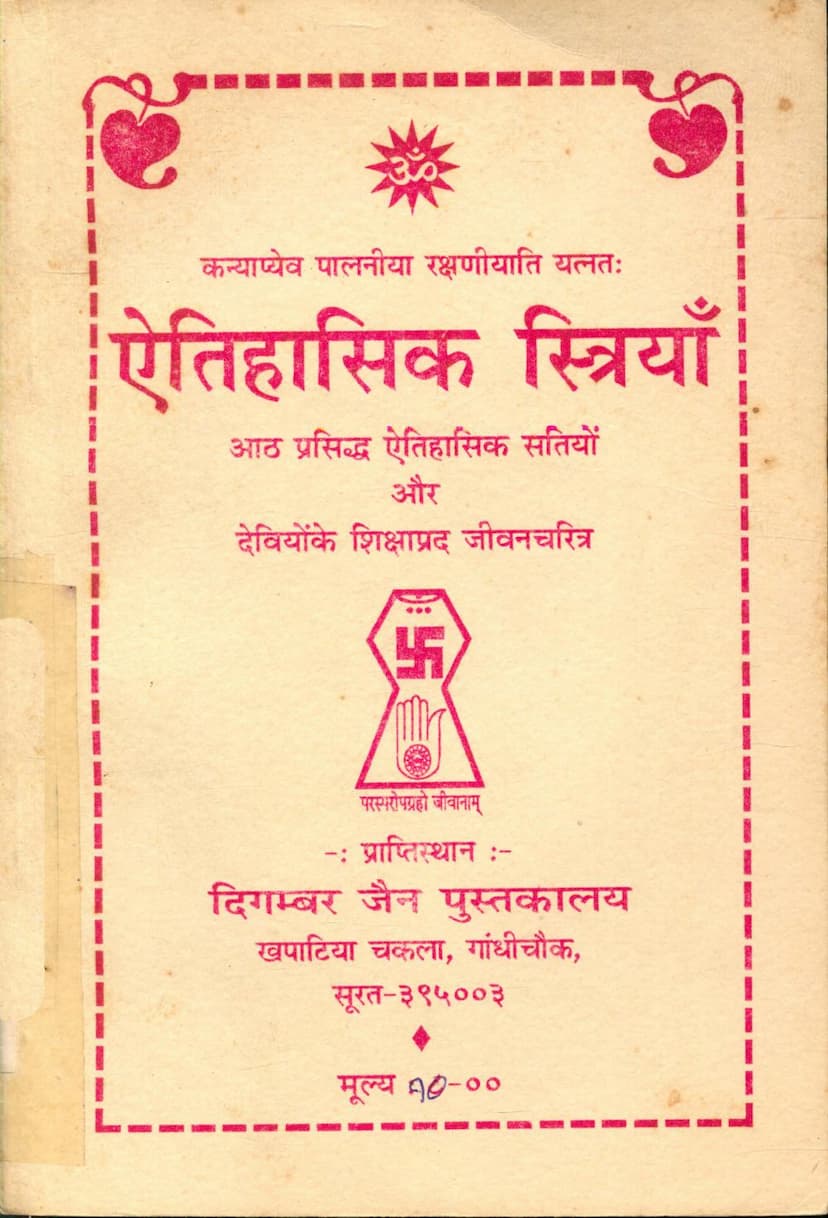Aetihasik Striya
Added to library: September 1, 2025

Summary
Here's a comprehensive summary of the Jain text "Aetihasik Striya" by Devendraprasad Jain:
Book Title: Aetihasik Striya (Historical Women) Author: Devendraprasad Jain Publisher: Digambar Jain Pustakalay, Surat Theme: This book presents the inspiring life stories of eight renowned Jain historical virtuous women (Sati) and divine ladies (Devi), emphasizing their exemplary character and moral teachings.
Core Message: The central tenet of the book, "Parasparopagraho Jeevanam" (Mutual support of living beings), underpins the narrative. It highlights the importance of emulating the virtues of these historical women for the moral and spiritual upliftment of women and society at large.
Purpose and Target Audience:
- The book aims to fill a gap in Hindi literature, particularly in providing inspiring and exemplary lives for women to follow.
- It is intended for young girls, women, and all readers who seek moral guidance and inspiration.
- The publisher and contributors express a strong desire for this book to be included in the curriculum of girls' schools to instill strong moral values in students.
Key Figures and Their Virtues (as detailed in the provided pages):
-
Smt. Rajuladevi (Rajamati): Daughter of King Ugrasena, she was a princess destined to marry Lord Neminath, the 22nd Tirthankara. Upon witnessing the slaughter of animals for his wedding feast and understanding the ephemeral nature of worldly pleasures, Neminath renounced the world. Rajuladevi, deeply affected by this renunciation and embodying profound chastity (Shilam) and detachment, followed him by adopting asceticism. Her story emphasizes renunciation, unwavering devotion to her husband's path, and the importance of self-control.
-
Smt. Sitaji: A princess from the Ikshvaku dynasty, she was the consort of Lord Rama. Her life journey exemplifies purity, unwavering fidelity (Pativrat), courage in adversity, and steadfastness in upholding Dharma. Despite facing immense hardships, including abduction by Ravana and societal suspicion leading to her exile, Sita maintained her integrity and inner strength. Her story teaches how to protect one's Dharma even in difficult circumstances.
-
Maharani Chelnadevi: The queen of King Shrenik of Magadha. She was a devout follower of Jainism and played a crucial role in converting her husband, a Buddhist, to Jainism. Her life showcases strong faith in Jain principles, persuasive intellect, patience, and the ability to guide loved ones towards righteousness. Her clever methods of testing the true nature of religious figures highlight her wisdom and determination.
-
Smt. Mainasundari: The youngest daughter of King Pahupal. She bravely married King Shripal, who was afflicted with leprosy. Despite societal disapproval and her father's anger, Mainasundari's devotion, care, and adherence to religious vows (like Ashtahnika Vrat) miraculously cured her husband. Her life is a testament to unwavering loyalty, the power of devotion and penance, and overcoming adversity through faith.
-
Veer Nari Rani Draupadi: A courageous and virtuous woman, wife to the Pandavas. While the text mentions her as a devoted wife to Arjuna, it strongly refutes the notion of her having five husbands, clarifying that she was a supreme chaste woman married to Arjuna. Her life highlights strength of character, resilience in the face of immense insult and suffering (like the disrobing incident), and devotion to her husband. She demonstrates remarkable fortitude and self-reliance.
-
Rani Anjanasundari: Daughter of King Mahendra. She endured a separation of 22 years from her husband, Vayukumar, due to a misunderstanding and his subsequent departure to war. Despite facing neglect from her family and immense hardship, she maintained her virtue and eventually reunited with her husband. Her story emphasizes patience, unwavering loyalty, resilience, and the ultimate triumph of good deeds. It also highlights the concept of karmic consequences from past lives.
-
Smt. Manoramadevi: Daughter of a wealthy merchant, she was a woman of exceptional chastity and devotion. After being falsely accused and abandoned by her husband and father, she faced severe hardships in the forest. However, her virtue and unwavering faith protected her from harm, and she was eventually reunited with her husband. Her life exemplifies unwavering chastity, inner strength, and the power of divine intervention and faith.
-
Smt. Rani Rayanamanjusha: Daughter of King Kanakketu. She was married to King Shripal, who, after being miraculously cured of leprosy, faced further trials. She displayed remarkable courage and fidelity when the merchant Dhavalsheth attempted to harm her chastity after Shripal was thrown into the sea. Her unwavering devotion and virtue ultimately led to her reunion with Shripal and the downfall of the wicked Dhavalsheth. Her story underscores extreme loyalty, steadfastness in virtue, and the power of righteous resistance.
Overall Impact and Significance:
- The book serves as a moral compass and a source of inspiration, particularly for women.
- It aims to promote a deeper understanding and adherence to Jain ethical principles.
- The reprinting of the book for its tenth edition signifies its continued popularity and relevance in conveying valuable life lessons from these historical Jain women.
- The inclusion of preface notes from respected individuals like Shri. Brahmachari Pandita Chandabaiji and late Shri. Jugmandirlalji Jain Barrister and High Court Judge further enhances the book's credibility and importance.
In essence, "Aetihasik Striya" is a significant Jain text that celebrates the strength, virtue, and spiritual fortitude of its featured women, offering timeless lessons on dharma, devotion, resilience, and the pursuit of spiritual liberation.